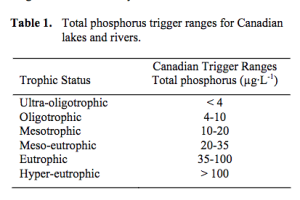While for many types of plant and animal communities, higher productivity is associated with desirable features, such as more species and larger wildlife populations, more carbon capture, more food to harvested etc, for many types of lakes including most lakes in Canada and in Nova Scotia, the reverse is true or often true – the lower the productivity the better, or at least they are from a human perspective.
The lowest productivity lakes are typically “cleaner”, have fewer “aquatic weeds” than higher productivity lakes, and they generally host the most desired sport fish, the salmonids, while those are often excluded in higher productivity lakes. Typically lakes in unsettled landscapes have low productivity, and with increasing urbanization, productivity increases because of increased nutrient inputs, e.g. from runoff of fertilizer from turfs, pet feces etc, and release of sediment and nutrients when soil is disturbed.
Commonly lakes are classified into one of three major “trophic states” based on their productivity. The following extract from a page on “Lake Trophic State” by Brendan Wiltse, posted at allaboutlakes.org, provides a concise overview of the three major trophic states – Oligotrophic, Mesotrophic, Eutrophic, plus a variant, a “hypereutrophic” state.
Lake Trophic StateOligotrophic Lakes are the least productive. They characteristically have clear water, with high water column transparency The water column will also be well oxygenated, which, depending on temperature, may allow the lake to support cold-water fish like trout and salmon. These lakes are also often preferred for recreational activities such as swimming, paddling, water skiing, diving, and boating. Mesotrophic lakes are moderately productive, and their water clarity is lower than oligotrophic lakes. The higher primary production results in more algae, which decreases transparency. In addition, higher primary production results in increased bacterial decomposition of organic matter. Bacteria consume oxygen during decomposition, which results in decreased oxygen concentrations in the deeper waters of mesotrophic lakes. Lower oxygen concentrations in the deeper waters make it less likely that these lakes will support cold-water fish. Mesotrophic lakes are often good for fishing for warm-water species such as yellow perch, bass, and northern pike. Eutrophic lakes are highly productive. The water clarity of eutrophic lakes tends to be very low. Eutrophic lakes may have algal blooms problems and taste and odor issues. The high levels of primary production and decomposition will result in low levels of dissolved oxygen, affecting fish and other aquatic organisms. These lakes will have only warm-water fishes, predominately bass. Hypereutrophic lakes are incredibly productive, they are typically dominated by algae scums at the surface, and their transparency is less than 1.5 feet (0.5 meters). These lakes are so productive that they may experience extremely low dissolved oxygen due to decomposition, even in the surface waters, resulting in summer fish kills. The description continues with comments on Factors That Influence Trophic State (Nutrient Supply, Lake & Watershed Shape, Lake Aging, Cultural Eutrophication – see allaboutlakes.org |
Total Phosphorous Level as Predictor of Trophic State
For many lakes and most lakes in NS, it has been shown that the Total Phosphorous level in samples of surface water collected in the spring is a good predictor of the lake productivity, and hence of its trophic state. The table at right shows the generally applied “Trigger Ranges”for Total P in Canada. Source: Canadian Council of Ministers of the Environment. 2004. Canadian water quality guidelines for the protection of aquatic life:Phosphorus: Canadian Guidance Framework for the Management of Freshwater Systems. In: Canadian environmental quality guidelines, 2004, Canadian Council of Ministers of the Environment, Winnipeg Available at https://ccme.ca/en/res/phosphorus-en-canadian-water-quality-guidelines-for-the-protection-of-aquatic-life.pdf
Note that six Trophic states are distinguished, 3 of them variants of the Ologotrophic, Mesotrophic and Eutrophic States. Often agencies making use of this classification cite only the 3 major states, combining them with some of the variants, e.g AECOM 2014 distinguishes between Oligotrophic (0-10 ug/L Total P), Mesotrophic (>10.o to 20 ug/L Total P) and Eutrophic (>20.o ug/L Total P)
More Useful Links
– Water indicators – Lake trophic status
Alberta Gov. “Water monitoring results for chlorophyll-a and total phosphorus concentrations and Secchi depth.”
–Pages from Urban Lake Management, “A Periodic Bulletin on Urban Watershed Restoration and Protection Tools”, Vol. 3, No. 4 — December 2001 By Center for Watershed Protection:
– Managing Phosphorus Inputs Into Lakes Introduction
– I. Determining the Trophic State of Your Lake by Ted Brown and Jon Simpson
– II. Crafting an Accurate Phosphorus Budget for Your Lake by Deb Caraco and Ted Brown
– III. Evaluating the Impact of Watershed Treatment by Deb Caraco
– The Influence of Septic Systems at the Watershed Level by Chris Swann
Also view the subpage to this page, Extracts… (About P); and lit. relating to Phosphorous on the top level page (Lit and Links)

